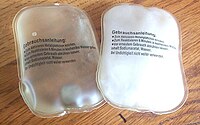
Photo from wikipedia
Abstract The coffee ripe red bean is a worldwide food commodity consumed mainly as a beverage made from the roasted beans. A secondary product of the coffee industry is the… Click to show full abstract
Abstract The coffee ripe red bean is a worldwide food commodity consumed mainly as a beverage made from the roasted beans. A secondary product of the coffee industry is the oil extracted from unripe green beans. This extraction generates a solid green coffee cake (GCC) with potential to be applied as polymer composite reinforcement. For this purpose, the GCC must be treated to improve the reinforcing characteristics. The present work investigated initially the treatment of GCC by the steam explosion process and then evaluated the use of treated GCC fibers as reinforcement of composites with polypropylene (PP) matrix. The best GCC/water ratio was first determined in a steam jet reactor in association with thermogravimetric analysis. PP composites incorporated with 2 and 5 wt% by GCC fibers were fabricated by extrusion. Both plain as received and the best steam-blown GCC/PP composites were characterized by differential scanning calorimetry (DSC) and dynamical-mechanical analysis (DMA). The incorporation of treated GCC provided a higher thermostability to the composite, disclosed by DSC, as compared to the plain PP reference sample. It was also revealed that incorporation of treated GCC increased the composite degree of crystallinity. The DMA showed an improvement in the storage modulus in the range of 14–22% and decrease in the glass transition in PP/fiber composites compared to plain PP.
Journal Title: Journal of materials research and technology
Year Published: 2020
Link to full text (if available)
Share on Social Media: Sign Up to like & get
recommendations!